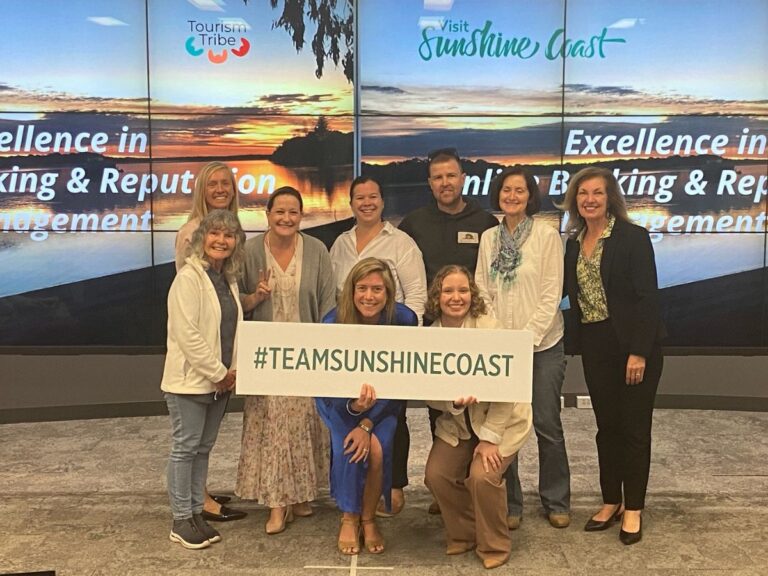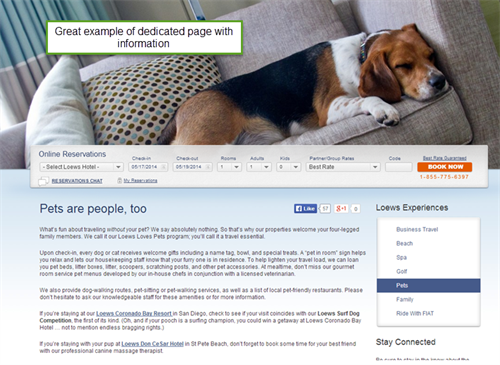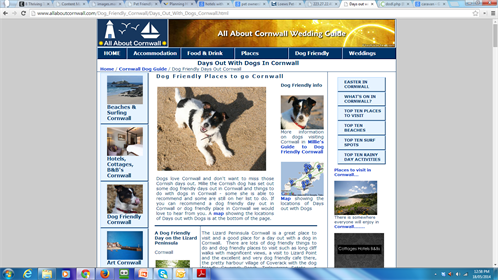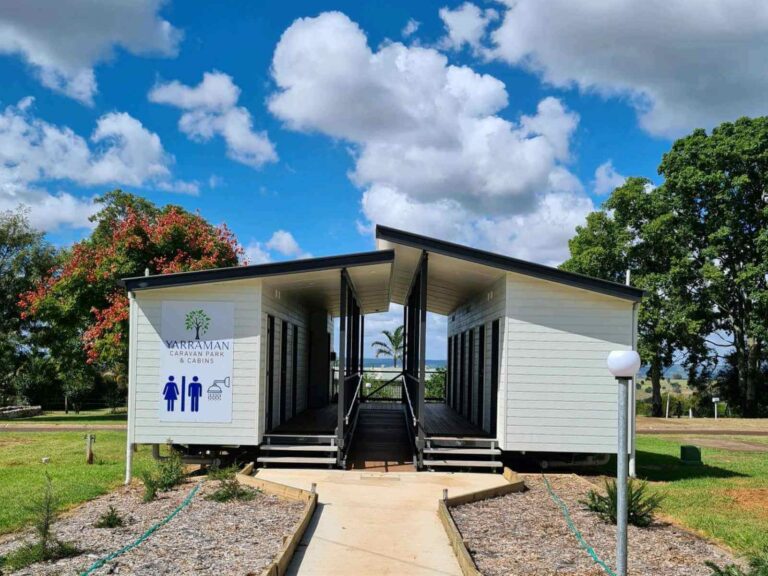
Visit Sunshine Coast SHINE Digital Transformation Program – Tourism Tribe Training
Shining a spotlight on tourism businesses committed to digital upskilling in an increasingly digitised world through our successful Tourism Tribe Training Program

Many of us come into the tourism business because we love delivering the tourism experience. We can often confuse that passion with being a job description.The reality is, the passion isn’t necessarily going to turn you into an instant marketing guru and send customers through the door.
Unfortunately business is a pretty unforgiving discipline. We don’t get to just cherry pick the bits of our role we like and ignore the bits we don’t like. As we are constantly being told by the business gurus, if you run a small business you need to spend most of your time on the business not in the business.
So, when you open your doors for business, you also appoint yourself to be the Chief Marketing officer (CMO) amongst the many other roles of your business.
As tourism providers, we have limited time and budgets when working on our business, which is why it is so important to get your priorities right in your marketing spend. Online marketing presents a great opportunity to create targeted marketing campaigns that you can measure and monitor along the way.
Without customers, your business just would not survive. We find that many small to medium tourism businesses do not place enough importance on marketing This can be for many reasons such as lack of money, lack of understanding or perhaps an overwhelming sense of where do I start.
The fact is, it can be overwhelming. Each week there is a new social media site and new marketing term. However, we are luckier than we were say 10 years ago when it comes to marketing our businesses.Travel, is the most consumed and searched product / service on the Internet. What a great opportunity for the tourism industry. Back in the olden day 10 years ago, you had to spend money on brochures, print advertising or telesales and partake in hope marketing practices hope for the best.
Now, the Internet has made access to your potential customers on their path to purchase so much more affordable and achievable.
The key is to remain focused.
Efficiencies in online marketing come in truly knowing and understanding your customer. Knowing their personas, how they think, where they hang out on social media and knowing their pain points.
By knowing your customer intimately and what drives them, you will be able to prioritise not only what you spend on your marketing budget but where you spend your all important valuable marketing time too.
As CMO, your primary job, is to set your marketing objectives, find out what people want and then you deliver it to them preferably at a profit.
Your customer is key to the marketing process not your product or service. A common problem we see in the travel industry is that people develop a product or a service and then try to find the customers. This is back to front marketing.
Having a clear marketing strategy and marketing plan for your online and offline activities provides a roadmap to delivering true value to different and distinct groups of customers. It also delivers true value and return on investment for both your time and money invested.
By working with a marketing plan you will immediately see the benefits. These include:
Simply put, customers are no longer a given just because you open for business, provide a product or service, doesn’t mean anyone will buy it.
The first place to start in any marketing scenario is with the objectives. What marketing wins do you want to achieve over your chosen time period? By setting objectives, you are able to measure your success and monitor your progress along the way.
Ensure your objectives are quantifiable; this makes them easy to measure your success. Examples of quantifiable results that you expect your marketing plan to achieve include:
The key is to choose realistic objectives that are achievable BUT challenging. Start with 2 or 3 that you think you could achieve. And this is not a set and forget process. You should come back each month and check in on your objectives. Leave room for tweaking and adjust to market conditions or environmental considerations beyond your control.
Knowing your customer is where all efficiencies start and end. Without a persona, you really are marketing blind, hoping that it will work. Knowing your customers and creating your persona is the main piece of the jigsaw that helps you prioritise your marketing spend when it comes to online marketing, or any marketing efforts.
You can’t be all things to all customers.
One of the most important exercises in your marketing is identifying the people you want to direct your marketing efforts toward. Targeted marketing is about knowing where to concentrate your forces, budgets and marketing efforts. Targeting your marketing toward your personas is most efficient place to start in developing a marketing program.
It is best practice in marketing to choose types of customers that share common characteristics and you can group them together. In marketing, historically, they have also been called segments, target markets or personas.
A persona is like a person, people or someone who belongs to a certain interests groups. Think of a persona like your best friend. The aim is to create a fictitious person, family or couple for example that represent your customers.
When you create your personas, you can make decisions and directly speak to them in your marketing. By creating a persona for your product or service you are able to make decisions with clarity, with your persona in mind. As silly as it seems, they should become your best friend. Each time you make a marketing decision, you need to ask yourself:Would my persona like this?
Your personas may be simple or complex characters. They can be defined by any or a combination of the following descriptive characteristics:
The key is to paint a picture of the person or people that represent your customers. And then, you can make decisions based on whether or not they would like it or if it would be good for them.
Examples of personas in the travel and tourism industry we often see are families, seniors, couples, special interest or niche tourism.
By creating a persona, giving them names and visualising them, it is easier to do your marketing it also makes it a lot of fun.By visualising and getting to know your persona, it will be easy to cater to their needs. Consider them to be your best friends and make all of your marketing decisions with them in mind asking yourself if they would like it.
Here are some of the things to consider:
A great tip is to think about some of the frequently asked questions from your customers
In this example, we create a persona for a couple who have decided to travel with their beloved pooch. We are seeing more and more tourism operators catering to animals.
The first step was to do a little background research on pet ownership this helps us identify if it is a viable market. We may have an inkling, and experience in our own business may tell us that it is a viable market, but it is always good to do a little practical research to confirm what you know. In market research, we say that you will know 80% of the result.
Background research, assess the market, create personas
Once you have done a little research on pet ownership, put that together with what you know about these types of customers. You will often know by information you have collected on your own customers both formally and informally.
Simply ask them questions about what concerns they have and what motivates their decisions. Ask them how they find information about travelling.
And importantly, ask them what it is they like most about your property, service or destination and always ask about what can be improved.
You will be really surprised at how easy it is to paint a picture of your persona / target market.
We have travelled and gone on holidays all our life, but someone has always looked after Lucky for us. We intend to be gone for around 12 months this time and would like to take Lucky with us.She is such a big part of our lives.
Now is the time to think about your product or service. Try to think about it from the perspective of your customer and your persona. You will need to do this for each persona you have identified which could be 1 or 2 or it could be a few. Each persona will have different needs and pain points.
For example, families want different things than say a couple or seniors travelling with their beloved pets. But they may all be personas you are dealing with and they may all be personas attracted to your product, service or destination.
So in our example of Bob and Shirl, what is it about your property that they would like, how can you help them. Let’s look at an example of a holiday or caravan park that caters to pets.
Your holiday park has made the decision to focus on the travelling with pets niche you have noticed an increase of your seniors travelling with pets and you have also noticed an increase in the number of inquiries.
You have done a bit of research and asked your customers about what you could deliver to make the experience great.
As a result, you have created a product that can help them:
It is no longer good enough to have a website with generic static information that doesn’t change. Our travelling customers are becoming more demanding of information and researching their holidays thoroughly.
This is why it makes marketing sense to ensure the information to place on your website appeals to your personas. It is more important since you will be spending time and potentially budget on your online marketing activities
There is also another element to having the right information on your website. The search engines (like Google and Yahoo) are such that they need lots of words, photos and videos to figure out what your site is all about. It is the search engines job to match the search query of the traveller to the best and most informative page. If you have scant information on the page with no context, your page will be deemed inappropriate.
Your content should be interesting to people on social media. As you create compelling and interesting content, you can post it to your social media. As people engage, share and comment, it sends signals to the search engines to say hey, people are talking and noticing this site.
Focusing on content that is targeted and of interest to your personas and engages social media is the most efficient way to spend your online marketing time and budget
Ensure the information on your website meet their needs. Your marketing content should include:
And believe it or not, the search engines can now figure out what the photo is about.
Video
You can make videos yourself or have the professionally made. Video marketing is becoming more and more important
Let’s take a look at the type of content we could create for Bob and Shirl.
A blog from the perspective of your dog


The next job is to get your content, your words, images and videos to the people / personas.
How do we do this?
How you do it has a lot to do with your budget. You will need to choose between owned, earned and bought media. Or, you may be in a budgetary position to have it all. This is possible, but it is important to work out up front how much time and money you can dedicate to distributing your online marketing content.
Ideally, you would include all of these things, but we know that it is not realistic in small business. It is important to understand where your persona gets their information. One size does not fit all. Some personas like Facebook, some like Youtube, Twitter or something else. We are not going to recommend here where to throw your efforts and budget. You will discover this when you do your research on your target market persona.
Quite simply, it’s all the advertising you pay for. This includes amongst other things:
Owned media is what you should focus on. That is the media, content and online properties (like your website) that you control:
Earned media is like public relations. It’s the free publicity generated by your fans or often journalists, both online and offline. You didn’t pay for it, because you earned it. This can include:
Once you have looked at your budget, you need to find out where your personas hang out. You will have probably found this out in your initial research or you may know by having asked them or previous marketing efforts.
Things to look at include:
Every time you add content, make sure you do the following automatically. All of these things are free:
Email your database of customers to let them know
Look for sites and forums that directly connect with your persona. Check out this great site here http://www.bringfido.com/advertise/. Bring Fido is a site dedicated to travelling with pets and they have a whole range of paid advertising options
As with many things in life, nothing comes for free, so you need to work hard to earn your media.
By working hard, we mean by not creating boring irrelevant factual content. Be imaginative and fun. You are after all in the travel game and your job is to inspire and excite ultimately lead to a booking
If your online marketing content is relevant, and interesting, you will earn your media through shares, retweets, comments and possibly be referred to in other blogs
Typically, we measure over a year. Your success should be measured and matched to your original objectives. Do you have the answers to some of these questions and objectives? Our examples were:
This is where we need to say that the online marketing and content creation process is an ongoing process. You must create online content on a regular basis. It is not just a once off. So ask yourself, have I been creating content for my customer that is interesting on an ongoing basis. If not, start doing it, a couple of times a month at the very least.
If that isn’t working, then it is time to go back to basics, revisit your persona and revisit your product. You may need to do a little more market research into what drives your customers and what they want.
1.What are your marketing objectives?
2. Who is your customer? Create your own personas
3. Your product
4. Content creation
5. Where are your personas hanging out and where are you going to distribute your online content?


Shining a spotlight on tourism businesses committed to digital upskilling in an increasingly digitised world through our successful Tourism Tribe Training Program

Discover the path to small business success through Tania’s inspiring journey at Yarraman Caravan Parks & Cabins and gain valuable insights from her expert advice.

Tourism Tribe’s research examines the digital capacity of Australian businesses, emphasising marketing assets and the potential benefits of incorporating AI. Key findings highlight areas for improvement.